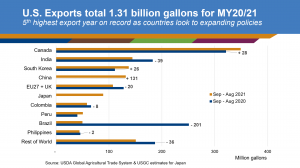
The 2020/2021 marketing year recorded the fifth-highest overall export total for U.S. ethanol, 1.31 billion gallons, despite market challenges due to COVID-19.
Exports were down eight percent from the previous marketing year, reflecting the challenges pandemic restrictions have had on fuel demand and trade.
While industrial exports remained strong, they sagged slightly relative to the surge of sanitizing application demand from the outset of the pandemic. Looking forward, more aggressive blend rates that have been set, or will need to be set to meet emissions reduction goals, will support increased global ethanol demand and trade.
Canada remained the top market for U.S. ethanol, purchasing more than 28 percent of all U.S. ethanol exports in 2020/2021 at 349 million gallons.
While India does not allow fuel ethanol into the country, it remains the largest market for industrial ethanol. The country exported 144 million gallons in 2020/2021, making it the second-largest export market for U.S. ethanol overall.
South Korea came in as the third-largest market, exporting 137 million gallons, a 23 percent increase from the previous year. Another strong industrial-use market, Korea is currently exploring ways for the transport sector to reduce emissions.
China and the European Union (EU) rounded out the top five markets in 2020/2021. Exports to China were more than 131.7 million gallons, while the EU purchased over 88.1 million gallons.
Looking forward to the 2021/2022 marketing year, three factors will impact global ethanol demand: policy enforcement; inclusion of ethanol in greenhouse gas (GHG) emission reduction policies; and creating tariff equity for ethanol with other transport energy products.
India, the United Kingdom and Colombia are key examples of the importance of policy enforcement impacting global demand for ethanol. The U.S. industry is poised to support these countries in full implementation. Japan, Korea and Taiwan have announced net zero targets by 2050, and ethanol can have a role in meeting those goals, making collaboration with local industry and government a priority when demonstrating that feasibility. Finally, tariff parity with other energy products must be realized to ensure ethanol is able to competitively access these markets.

